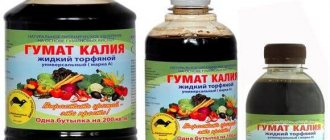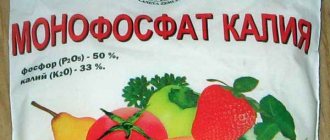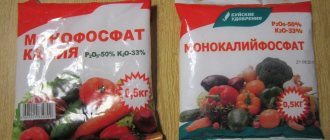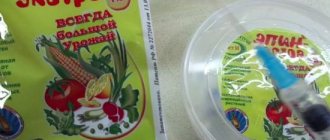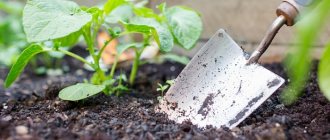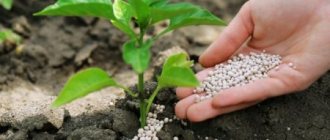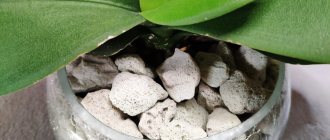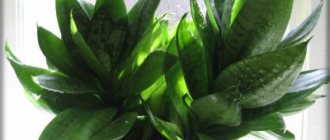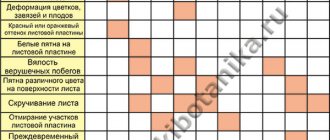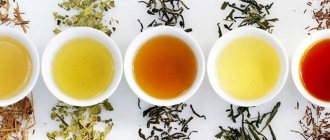Home / Preparations and fertilizers
Back
Published: 09/26/2021
2
5/5 — (1 vote)
Many summer residents have to grow vegetables in infertile areas. To enrich the soil, various methods and means are used, among which is potassium humate.
Thanks to organic fertilizer, they not only increase the natural fertility of the soil, but also accelerate plant growth and shorten the harvest time. The result is visible only with proper application of fertilizing, otherwise it is easy to harm the crops.
- 1 Composition and characteristics
- 2 What is it used for?
- 3 Types of potassium humate
- 4 Instructions for use
- 5 Analogues
- 6 Compatibility
- 7 Storage rules
Potassium humate liquid - application for different types of plants
The instructions for using potassium humate indicate the dosage, method of dilution and features of use for different types of crops.
The drug is sold in both small bottles and canisters and is a brown liquid. This is a concentrate that is diluted with plain water before use - just add 0.1-0.2% of the substance. Further, the working solution can be used in different ways:
- Soaking seeds is a procedure that significantly improves germination rates. It is enough to soak the bulbs in a diluted solution for 8 hours, the seeds for 24 hours. Seeds of cucumbers and ornamental flowering plants can be left for 2 days.
- Spraying is the easiest way to apply fertilizer. The substance is perfectly absorbed through the green mass of plants and is used to maintain biochemical processes. The solution is distributed from a spray bottle using a respirator and a protective suit. For potted plants, you can take a bottle with a special spray nozzle.
- Watering - this method of applying fertilizer is used if there is a need to improve the properties of the soil. It is better to carry out the procedure in early spring, several times with an interval of 10 days. For one plant you can add from 500 ml to 1 liter of working solution of potassium humate.
- Soil treatment - for this method it is better to purchase fertilizer in powder form. It is combined with ordinary sand and scattered over the surface of the soil in early spring. For 10 m2, 50 g of the drug is enough. The substance will be absorbed into the ground with melt water, but you can also apply it in the warm season, and then dig up the area.
Dosages for different types of plants
Potassium humate is a universal fertilizer that is useful for different crops
For each of them, it is important to follow a feeding schedule so that the plants receive a sufficient amount of nutrients.
Experienced gardeners recommend adhering to the following schedule:
carrots, zucchini, white cabbage, beets - 4 sprays per season, as well as soil treatment before planting; potatoes - additional soaking or spraying of tubers before planting in the ground; cucumbers and tomatoes - at least 3 sprays during the warm season, soaking the seeds; greens - watering in the amount of 3-10 liters per meter of planting;
fruit and berry plants - it is important to apply fertilizers in early spring, as well as during the period of flowering and fruit set; indoor plants - 1 spraying every 2 weeks during the warm season, 1 spraying per month in winter.
Liquid potassium humate is a useful additive that improves the endurance and productivity of crops. It can also be used for ornamental plants, since humus is not produced in pots. The instructions for use indicate how to dilute potassium humate for indoor flowers, vegetable and fruit crops, garden plants and herbs. The product is stored in concentrated form, so for treating large areas it will be needed in a minimal amount.
Safety measures and first aid
Humate +7 microelements does not accumulate in fruits and soil, and is not phytotoxic. The product is safe for wild and cultivated plants if you strictly follow the instructions for use.
Too much of the drug provokes growth inhibition, reduces resistance to bacterial diseases, and in extreme cases, an overdose causes plant death.
If the dose is exceeded, the plants should be watered abundantly to wash the excess into the deep layers of the soil. After this, loosen the soil and do not water for several days.
Indoor flowers, if these measures do not have an effect, should be transplanted into another substrate.
The drug can be harmful to plants if the soil is very acidic. Humate will aggravate this indicator, while most vegetable plants prefer slightly acidic or neutral soils.
The use of the product is possible with liming before applying the drug. In an overly acidic environment, many minerals form insoluble compounds; alkalization after feeding with humate will not return them to accessible forms.
When preparing the solution and applying it, the following safety precautions should be observed:
- Work in special clothing, gloves, safety glasses and a respirator.
- Do not eat, drink or smoke until the end of the procedure.
- Remove children and animals from the work area.
- Prepare the solution in containers that are not used for preparing or eating food, storing or consuming drinking water.
- After finishing work, wash your hands and face with soap, take a shower, and wash clothes.
If the product or its solution gets into your eyes, rinse them with a large volume of water at room temperature.
If the drug is swallowed, take activated charcoal and drink plenty of water. If you experience pain in the abdomen, eyes, skin, rash, or burning sensation, seek medical help immediately.
Potassium humate - use “not according to the rules”
Liquid and solid
Whether you use liquid humate or powder does not really matter. Anyway, it is added in the form of a solution with a low concentration of the active substance. The main advantage of the powder substance is ease of transportation and storage. It is much more important to know what kind of potassium humate you have:
- ballast;
- ballastless;
Ballast is used as a fertilizer, and non-ballast is used as a growth stimulator. But this division is to some extent formal. After all, the effect of humic preparations on plants is the same in both cases.
Features of sodium humates
Just in case, let's pay attention to sodium humate. It is ideal for processing tomatoes, beets
But excess sodium has a depressing effect on other crops, so do not overuse treatments. This type of humic fertilizer is the cheapest to produce, so they are widely used, despite some specificity. And the method of using them is the same.
Potassium humate liquid - application and origin
Peat humate and those obtained from coal are slightly different. Over time, water washes out fulvic acids from coal. Humic acids are large, unwieldy molecules. Water can’t wash them out, so they don’t go anywhere. Therefore, many farmers prefer peat and use liquid peat potassium humate. Liquid, by the way, because this form is more convenient. The above does not mean at all that the effect of using a solution of liquid peat preparation will necessarily be better. It all depends on your goals. For example, humic acids bind toxic substances well in the soil. In this case, the low content of fulvic acids is definitely not a disadvantage. On the other hand, in Lignohumate the proportion of fulvic acids in humic substances reaches 40% - more than in peat stimulants.
Release form
All green spaces are capable of processing nutrients in liquid form. Manufacturers produce fertilizer in various forms. It is made by extracting essential nutrients and microelements from peat. Liquid fertilizer is convenient to use and is also very effective. This form of peat potassium humate is a product dissolved in water. The concentrate is better absorbed by shoots and roots.
Fertilizers in tablets are convenient for those who have just started gardening, as there is no danger of overdose. The weight of the tablet is 14 g. If you plan to soak the seeds, the tablet is diluted in 3 liters of water, for foliar and root feeding - in 50 liters.
Fertilizer in the form of dry humate must be diluted in water according to the instructions for using potassium humate. You can achieve good results:
- good humus is formed faster;
- the fertility of the land increases;
- productivity doubles;
- The fruits ripen a little earlier.
Important! Gel and paste are most effective. The molecules in them are extremely active, they penetrate perfectly into all parts of the plant. Potassium humate “Prompter” is universal
Plants are fertilized with it, starting from March and ending with September - 2 times a day, and in October-February - 1 time every 45 days. The working composition is prepared only before use. In terms of general action, all products that contain potassium have approximately the same effect on plants: they become strong and slightly sensitive to wrinkles and spotting. Fertilizers can be complex (with microelements) or simple
Potassium humate "Prompter" is universal. Plants are fertilized with it, starting from March and ending with September - 2 times a day, and in October-February - 1 time every 45 days. The working composition is prepared only before use. In terms of general action, all products that contain potassium have approximately the same effect on plants: they become strong and slightly sensitive to wrinkles and spotting. Fertilizers can be complex (with microelements) or simple.
Some gardeners prefer to use potassium sulfate, which is white crystals. It can be used for all crops and does not contain chlorine. Potassium sulfate contains magnesium, calcium and potassium, it also contains additional microelements, but still the fertilizer is quite simple. It dissolves quickly in water and is moderately toxic.
Ammophos fertilizer: composition, instructions for use, how to dilute Ammophos is a complex fertilizer that allows plants to cope with the deficiency of such important elements as nitrogen and...
World of humates
Humates are a subtype of humic substances found in transformed organic matter: in soil and lake silt, in peat and humus, and in addition, in fossilized plant remains - coal deposits. It is from such concentrated organic matter that manufacturers extract humic acids, and then combine them with sodium or potassium alkali. As a result of chemical reactions, special soluble salts are formed at the output - sodium or potassium humates.
There are no major differences between these two products. They are similar in their main properties and can replace each other.
Sodium humate is usually slightly cheaper in cost. It protects plants well from various stress factors (temperature, water exchange, infectious and many others). It is alkaline on the pH scale.
Potassium humate exhibits a neutral pH and a slightly wider range of influence. According to the instructions, it is especially useful for pre-sowing and pre-planting treatment (seed material, bulbs, tubers, etc.), for rooting seedlings, strawberry tendrils, and various cuttings. Possible joint use with other substances (fertilizers, microelements, many fungicides and pesticides).
If you look at the instructions as a whole, the differences between potassium and sodium humic salts are not too great. But the quality of the drug plays a decisive role. The products that are truly effective in use are those that are most fully absorbed by plants and have a high concentration of active substance.
Not very conscientious entrepreneurs can dilute ordinary cheap peat with water and call this product “humic fertilizer.” Formally, there is nothing to complain about: there are humic compounds there (as in any soil, swamp slurry, or piece of brown coal). However, the effectiveness is questionable. Large research and production companies create humic preparations using special technologies, focusing on high concentration and successful absorption of the substance by cultivated plants and soil inhabitants.
Advantages of good humates
- Low cost compared to other stimulants and fertilizers.
- Significant economic benefits (2 rubles of costs bring 100 rubles of income - a direct increase in yield and improvement in the quality of agricultural products).
- The shelf life and shelf life are not limited (although some instructions contain instructions for specific periods of use).
- Ease of use.
- Safety from an environmental point of view (for high-quality drugs purified from possible heavy metal impurities).
- Overdose is not dangerous.
- Can be used throughout the season.
- Good compatibility with many drugs.
- Universality in a broad sense: there are no restrictions on place, time, culture.
Principle of operation
The physicochemical mechanism of behavior for molecules of humic substances has not been fully studied, but scientists have determined that they resemble activated carbon: they attract and bind other molecules. From the seed or tuber they take chemical compounds that inhibit germination. Humates in a special way (like hormones) open the cell membranes of plants, improving the penetration of nutrition, but blocking access to infections and poisons. In the internal environment of plants, water metabolism and circulation of nutrients are improved. When humic compounds enter the soil, they attach to hazardous substances (pesticides, heavy metals, etc.) and reduce their harmful effects on the ecosystem.
Release forms
For ease of use, manufacturers produce different forms of fertilizer:
- Tablets are a convenient form that allows beginning gardeners to use the fertilizer without the risk of overdose. Usually they sell tablets weighing 14 g; for root and foliar feeding it is dissolved in a 50 liter barrel, for soaking seeds - in 3 liters of water.
- Instant powder or granules are a budget option, suitable for both dry feeding and for obtaining solutions of a certain concentration.
- Liquid potassium humate is a concentrate for large-scale use. Both root and foliar feeding is used.
- The paste and gel have the most active molecules, providing a high percentage of penetration and binding. Considered the most effective.
- Mixtures based on humic substances are preparations supplemented with amino acid complexes, natural growth catalysts, enzymes, and peptides. Such complexes are suitable for feeding most garden crops.
Analogues of potassium humate – Prompter, Athlete and other preparations
Fertilizers are sold both in pure form and with the addition of other substances necessary for the active development of crops. Prompter is a concentrate with a base of humic sapropel. It contains ideal proportions of all necessary organic and mineral substances. Suitable for soaking seeds, root and foliar feeding. Bottles of 250 and 500 ml are available for sale. Shelf life 2 years at temperatures from -20°C to +30°C. The “Prompter” line includes organo-mineral fertilizers for flowers, vegetable and fruit plantings.
Dosage of fertilizer "Prompter"
Humates can be supplemented with valuable minerals. A well-known complex with iodine is “Humate + 7 iodine”.
Humic potassium and sodium mixtures can be replaced with similar bioactive preparations. Such fertilizers include:
- growth stimulator Gumifield;
- growth regulator "Atlet", successfully used for growing seedlings;
- the drug “Heteroauxin” is one of the most powerful growth activators; it requires precise dosage;
- phytohormonal preparation based on the complex of sodium salts “Gibbersib”.
What are humates?
Humates are natural elements formed in the soil during the breakdown of plant fiber. They are also known as humic acids. These elements are classified as salts, which are based on sodium or potassium. For garden crops, humates replace fertilizers.
Humic acids are formed when they break down:
- peat;
- brown coal;
- sapropel;
- leonardite.
Among the listed elements, coal contains the smallest amount of humates. The volume of humic acids from the total composition of solid fuel is 5%. The easiest way to obtain humates is from leonardite. This component contains from 40% to 80% humic acids.
When humates get into the soil:
- stimulate the work of microorganisms;
- improve soil structure;
- promote the penetration of water and oxygen into the ground.
This improves the quality of the soil, which enhances plant development and increases productivity. Humates do not contain substances that are hazardous to the environment, which means they can be used in any conditions.
What is it used for?
The product is used on the site for various purposes:
- to improve soil structure, increase fertility;
- for growing crops.
When the mixture is added, dense soil becomes loose and allows air and moisture to pass through better. On loose soils, the effect is the opposite: the product increases viscosity, which is why moisture is retained well in the soil.
The addition of humate improves the microflora, as pathogens are suppressed, favorable conditions are created for the life of beneficial microorganisms, and biochemical processes are accelerated. It is interesting that when the composition is applied to the ridges, the color of the earth slightly changes: it becomes darker and is better warmed by the sun's rays.
The substance is an excellent sorbent, neutralizing the harmful effects of heavy metals and radionuclides. Due to the chemical activity of humate, they are converted into insoluble, and therefore non-hazardous, compounds.
Humate also has a beneficial effect on cultivated crops:
- increases the efficiency of fertilizing;
- strengthens plant immunity;
- promotes faster and better delivery of nutrients to the root system and leaves;
- stimulates the synthesis of plant hormones;
- suppresses the accumulation of nitrates;
- gives a good increase in yield (yield indicators with proper use of the drug increase to 45-50%).
The product is safe and non-toxic (hazard class IV), does not contain synthetic components, and combines well with most mineral fertilizers. It is used both on open ground ridges and in greenhouses.
Compound
Depending on the raw materials used, the composition of the fertilizer can be different - organic or organomineral. Based on this factor, humates are divided into two types - potassium humate and sodium humate. Both drugs are similar in their characteristics. Let's take a closer look at how their composition differs.
Composition of potassium humate
Under the influence of this drug, the soil is saturated with useful elements that can improve the biological, chemical and physical parameters of the soil. Thanks to this, crop yields increase, their growth is stimulated and their quality improves.
This product belongs to organomineral fertilizers made from peat. In addition to the high content of potassium salts of humic acids, the composition of potassium humate is saturated with low molecular weight fulvic acids and amino acids. Also, the presence of active trace elements such as cobalt, copper, boron, molybdenum, zinc and manganese provides the drug with high value.
Potassium humate is characterized by neutral acidity and a wider sphere of action compared to sodium humate.
Composition of sodium humate
It is a powerful plant growth stimulator. Under its influence, the number of shoots increases, immune resistance to diseases and negative climatic factors (drought, high humidity, cold snaps) increases. The drug exhibits high adaptogenic and immunostimulating qualities.
Sodium humate is made from peat, less often from brown coal. The high pH content of humate makes it highly effective on alkaline soils. The drug prevents premature falling of leaves and ovaries. In plant growing, it is widely used in both liquid and dry form. The stimulant does not exhibit toxicity, it is not mutagenic and does not have cumulative properties.
The composition of sodium humate includes sodium salts of humic acids (70% of them in the substance). Microelements include molybdenum, copper, cobalt, manganese and zinc. Heavy metals include lead and cadmium. The dry composition contains nitrogen, phosphorus, potassium, magnesium, and calcium.
Yield increase mechanism
Ways to increase crop yields under the influence of humates have been studied since the end of the 19th century. Especially a lot of data was accumulated in the 60s of the last century. The works of domestic and foreign scientists indicate the multifactorial influence of fertilizers on soil and plants, manifested in the following effects:
- Increases germination and germination energy of seeds up to 100%.
- Binding of heavy metals and other toxic substances into compounds inaccessible to crops.
- The process of plant respiration under the influence of humates increases, which is expressed in an increase in their biomass.
- Root nutrition is stimulated.
- Humates help the plant absorb phosphorus, zinc, iron, and copper from inaccessible forms in which they are usually found in the soil.
- The microbiological activity of the soil increases.
- Soil particles acquire structure and retain moisture better.
All of the above effects together lead to a significant increase in yield without compromising product quality and the environment.
Production of humates
The separation of humates from peat is carried out in the process of several technological stages:
- The peat goes through two stages of cleaning, then grinding and drying.
- The powder is fed into the mixer and mixed with hydrogen peroxide. The result of the reaction is humic acid.
- Either sodium hydroxide or potassium hydroxide is added to the mixture.
- In a separate container, microelement salts are dissolved in water.
- The isolated humate is mixed in a mixer with microelements.
- The solution is filtered and then packaged in plastic containers.
The technology for producing humate from brown coal includes the following chain of actions:
- First, brown coal is ground into microparticles.
- Then a weak alkali solution is added to the crushed coal.
- In the mixing reactor, during the mixing process, ultrasonic action is applied to the suspension to extract humic acid from coal.
- In the settling tank for 15 minutes, solid particles settle and liquid particles are separated.
- Hydrochloric acid is added to the liquid solution. As a result, the mixture breaks down into water and humic acid.
Useful video on the topic:
Compatibility with other fertilizers
Humates improve the composition of the soil by interacting with the beneficial substances in it, and if the soil is poor in nutrition, the product will not be able to enrich it.
Humate +7 contains macroelements, which partly solves the problem of a depleted substrate, but the volumes of potassium, phosphorus, and nitrogen in it are not enough to limit it to just that. Other medications must be added.
Together with humates, you can give nitrogen and potassium in the form of mineral supplements. It is allowed to mix them with Humate +7 solution.
When applied together, reduce the doses of other fertilizers by 30% to avoid overfeeding.
Dissolve each substance in a small volume of water in a separate container and then pour them into one container. But if, when mixing humate with any substance, a precipitate forms, this solution cannot be used.
The stimulator Humat +7 is incompatible with phosphorus fertilizers; this can lead to the conversion of phosphates into insoluble compounds that are inaccessible to the roots.
Even with complex fertilizers, the drug should be alternated, especially since it cannot be used together with superphosphate, potassium monophosphate, etc.
It is advisable to add Humat +7 at least 2-3 weeks before fertilizing with phosphorus. In this case, 30% less phosphorus should be given. To restore the soil, it is optimal to add superphosphate in the fall, since it takes a long time to absorb, and humate in the spring.
The product is compatible with organic fertilizers. The preparation can be embedded in the soil together with manure or green manure.
Humate +7 stimulates the development of soil microflora; it is very useful to combine it with watering with bacterial preparations (Baikal EM-1, Siyanie, Vostok, Stimulin, Biovit and others).
This approach allows you to restore the fertile layer and attract earthworms very quickly.
Humate +7 can be mixed with any pesticides:
- fungicides;
- insecticides;
- herbicides;
- nematicides.
To check compatibility, combine small volumes of solutions and ensure that no precipitate has formed. In this case, the mixture can be used.
Composts are our everything
Surely every more or less experienced gardener knows how good organic compost is as a fertilizer. There’s just a problem: the tough parts of perennial plants, as well as weed seeds, take an extremely long time to rot, sometimes “delighting” garden owners even after several years. The peculiarity of humic acids is their ability to destroy the hard cellulose of dead plants. We invite you to take advantage of this property.
In addition, humates sharply increase the activity of saprophytic microflora, which also accelerates the maturation of compost and significantly improves its quality. To obtain high-quality fertilizer, about three months before application to the soil (at the end of spring, for autumn plowing), it is useful to irrigate the humus with a solution of humates, and the dose of fertilizer is calculated based on the need for approximately 10 grams of humic acids to decompose ten kilograms of compost.
General Tips
Specialists at the subsidiary farm Arzamas advise using potassium humate in a greenhouse to restore the root system of cucumbers.
After 2 months of active fruiting, there is a decline in yield and a deterioration in the quality and shape of cucumber fruits. The cucumber ripens crookedly, unevenly, and gradually becomes thinner. The reason is depletion and overload of the root system. It's time to feed the roots.
To resuscitate the entire bush, several sequential operations are performed:
- old spent shoots, damaged and withered leaves are cut off;
- cuts are made as close as possible to the main stem;
- pruning eases the load on the root system;
- Next, a solution of potassium humate is diluted at the rate of 1 liter of liquid fertilizer per 500-1000 liters of water (for drip irrigation);
- fertilizing takes effect within 2-3 days.
The plant growing company ORELSTART (Chelyabinsk) recommends using fertilizer for cereals - rye, wheat. Rapid germination of seedlings after sowing is noted.
Sodium humate is used primarily for processing onions.
The technical director of the company, V. Maleev, provides statistical data - the yield is 20-30% higher in those areas where the seeds were treated with this bioresource. By watering radish crops with potassium humate, the crop ripens faster by 7-10 days, the radish itself turns out juicy, without bitterness.
Is it suitable for all crops?
Experienced gardeners know that there are no truly universal fertilizers. So is this remedy as good as we just talked about it? Let us assure you right away: today there are no crops that would react negatively to humate. Almost always, the effect of its use is closely related to the characteristics of the soil on which your garden stands.
Note that fertilizers of this type are extremely useful on soils that contain very little iron. In addition, fertilizing with potassium humate is useful on alkaline (especially on them), saline and podzolic soils. But pouring a solution of the product onto black soil is pointless, since you still won’t notice any special effect. In addition, agronomists have identified several crops that respond particularly strongly to the addition of this substance to the soil:
- All nightshades respond well (including potatoes and tomatoes), as well as beets (and fodder too).
- Almost all grains show significant increases in yield.
- Legumes practically do not change the indicators in any way.
- Under normal conditions, sunflower and pumpkin do not react to potassium humate; its use is not advisable.
It is no coincidence that we emphasized that the latest plant species do not grow under “normal” conditions. If it's been a bad year or you've planted them in poor quality soil, humic acids can work wonders! In a word, you should experiment for yourself, making sure of the effectiveness (or ineffectiveness) of this product in the conditions of your garden.
Thus, potassium humate is still universal. Its use can be recommended in almost any cases. You can read about when you should not use it at the end of our article.
Folk fertilizers for tomatoes
In addition to purchased drugs, you can also use fertilizers you make yourself. But they need to be fertilized after the seedlings have been moved to the garden. For self-prepared fertilizing solutions, slurry, mullein or chicken droppings are most often used. But not in its pure form, but with the addition of feeding drugs in small quantities. Such mixtures provide an excellent effect for the growth and development of tomatoes.
It is best to prepare and apply nitrogen-containing or potassium fertilizers. This is cow manure and nitrophoska mixed in a bucket of water.
Another good feed would be chicken manure and potassium sulfate.
It is good to use fresh manure with yeast and ash (wood), mullein and boric acid infused in water for root watering.
While the plant is blooming, you can add an infusion of ash and water mixed with potassium humate.
The easiest way to fertilize tomatoes is to mix yeast and sugar, and after three days of fermentation, add wood ash. The use of such baits gives a good tomato harvest and fills the plant with useful elements.
Any fertilizing must be applied carefully, in small quantities, so as not to burn the plant and its roots.
https://galicina.com.ua/ru/kak-pravilno-i-zachem-ispolzovat-gumat-kaliya-dlya-tomatov/https://repka.online/ovoshhi/tomaty/preparatyi-i-podkormki/gumat- kaliya.htmlhttps://7ogorod.ru/pomidory/gumat-kalia-dla-rassady-tomatov.html
Instructions for use: how to dilute and use
The powder and liquid concentrate are diluted in water at room temperature. You can prepare the liquid composition yourself from granules, gel, or purchase a ready-made one. A powder-based solution will contain particles, so before spraying it is better to leave it for 1-2 days, then strain through cheesecloth. The concentration specified by the manufacturer cannot be increased so as not to harm the plantings.
Spraying tomatoes with the prepared solution
Soaking seeds and tubers
Recommended dosages for different crops are indicated on the packaging. To soak seeds and bulbs before planting, dilute 1/3 tbsp. l. liquid complex in 1 liter of water. Planting material is placed in the solution for 1-3 days.
Soaking duration:
- potato tubers – 12 hours;
- tomato seeds – 72 hours;
- cabbage – 48 hours;
- seeds of other vegetables – 24 hours;
- cuttings before planting - 20-24 hours.
Feeding standards for strawberries, vegetables, fruits
What to feed with humic fertilizer? Liquid preparations can be used to water home and garden flowers intended for cutting. Potatoes, carrots, beets and other root vegetables respond well to fertilizing the soil with potassium humate. For foliar spraying, prepare a weak solution of 3 g of powder per 10 liters of water. For a 100 m² area for spraying, 1.5-3 liters of solution is sufficient.
Memo for gardeners
Timing for the application of humic preparations and their approximate dosage for popular fruits and vegetables:
- Strawberry fertilization is carried out in several stages. First, the soil is prepared for planting, then the crop is watered to improve vegetation and fruiting, and in the fall it is prepared for winter. Solution for watering 5 m2: 10 ml of liquid product per 10 liters of water.
- Vegetable crops are fed before sowing and during the growing season. The optimal number of waterings during the growth period is 6 times. For carrots, zucchini, beets and cabbage, peppers, 5 treatments per season are sufficient.
- Seedlings of fruit and berry plants are treated with a solution when planting. They are also sprayed for additional nutrition. Fertilizing is carried out before flowering begins in the spring. The concentration of the irrigation solution is 100 ml per 10 liters of water. This amount is enough to treat 1 m2 of land.
Video about feeding tomatoes with a nutrient solution.
Potassium humate for the active growth of indoor flowers
The use of humic composition extends to indoor and garden flowers. Complementary feeding is carried out every two weeks in the spring. During the season, 3-5 waterings are enough. A solution for treating flowers is prepared from 100 ml of liquid preparation and 10 liters of water. For indoor flowers, humic additives are extremely necessary due to the impossibility of humus formation in a pot. In order for a home flower to actively grow and bloom beautifully, you will need to spray the leaves with a solution of 75 ml of liquid potassium humate per 1 liter of water. From March to September, processing is carried out once every 15 days.
Knowing how to care for indoor roses, homemade lemons, persimmons, and coffee trees, flower growers are sure to keep this nutritious product in their arsenal.
Main components of potash fertilizer
The name “potassium humate” refers to a complex of organic and mineral fertilizers, the effectiveness of which is scientifically proven. Thanks to its balanced composition, the drug has a gentle effect on the soil and crops. The presence of humic acids (75-80%) accelerates the development of most plants. When added to soil, the product helps normalize soil acidity and improve quality characteristics. Fruit and vegetable crops, garden and ornamental plants receive adequate nutrition.
This effect is due to the composition of potassium humate:
- amino acids;
- peptide amide bonds;
- enzymes;
- growth activators;
- substances that inhibit microbial growth.
Humic acids stimulate metabolic and biochemical processes in the soil. To obtain high molecular weight organic substances, brown coal, peat or lignosulfonates are used. In addition to fertilizing the soil, the drug is used for pre-sowing treatment of seeds, seedlings, seedlings and when transplanting adult plantings.
Please note: the bulk of nutrients are obtained by processing oxidized drill coal. This is due to the content of 85% humic substances in its composition. Fertilizing is carried out in two forms - without and ballast.
How to dilute potassium humate, instructions for use for different crops
Depending on the purpose of use, potassium humate is diluted in different ways, instructions for use vary.
To soak, you need to dilute 0.5 g (about a third of a teaspoon) of potassium humate per 1 liter of water. Seeds or plant bulbs are placed in the solution for a period of 8-12 hours to 2 days, while the cuttings are lowered to two-thirds of their length for about 14 hours.
Spraying the leaves is done with a weaker solution
– 3 g of potassium humate is diluted in 10 liters of water.
The preparation of fertilizer for irrigation is as follows: 1 tablespoon of potassium humate is dissolved in 10 liters of water - it is used for seedlings, and it is also appropriate to use it at a time when the plant is blooming or its buds are just appearing.
Important! Potassium humate is also used after treatment with pesticides for the purpose of detoxification. To do this, 50 g of dry powder fertilizer is mixed with sand or ash and scattered over 10 square meters.
For vegetables
Vegetable crops are treated with potassium humate before sowing, as well as during the growing season - application varies from two to six times.
For watering, take 50-100 ml of fertilizer per 10 liters of water and spend 3-10 liters per square meter, depending on the type of plant. Spray with the same solution one and a half to three liters per 100 square meters. Beets, cabbage, zucchini, and carrots will require treatment with potassium humate 4 times per season. Potatoes need to be soaked or sprayed before planting. Potassium humate is used for feeding cucumbers and tomatoes 3-4 times.
Seeds are soaked at the rate of 100 ml of liquid humate per liter of water for 24 hours, tubers and bulbs - for 10-12 hours.
For the green ones
These crops need to be processed two to six times throughout the season. A solution (50-100 ml of potassium humate per 10 liters of water) is used as irrigation - from three to ten liters per square meter. As a result, the richness of taste is preserved, the germination rate increases, and the level of resistance to adverse environmental factors and diseases in green crops increases.
For fruits and berries
Potassium humate for this type of crop is used when treating seedlings, roots and other parts of trees, shrubs, and herbaceous plants (by spraying). It is better to apply fertilizer together with the use of pesticides and herbicides.
Feeding with humate is carried out in early spring before the flowering period, when fruit ovaries form, as well as during the ripening period.
Did you know? Potassium promotes the accumulation of sugars in fruits, so fruits and berries become sweeter when using this fertilizer.
For garden flowers
It is recommended to fertilize garden flowers with potassium humate in the spring, when the growing season begins for perennial plants, and for annual plants - during the phase of full germination.
Then carry out from three to six feedings every two to three weeks. Seeds are soaked for a day before sowing, bulbs and tubers - for half as long. The solution is prepared as follows: take 50-100 ml of humate per liter of water. The same amount of potassium humate is used for irrigation (3-10 liters per square meter) and spraying (1.5-3 liters per 100 square meters), but per 10 liters of water.
For indoor plants
It is very important to use potassium humate fertilizer for houseplants, because humus does not form in the limited space of the pot. Feeding with this fertilizer stimulates growth and high-quality flowering in house plants
It is carried out during the period when the plants are actively growing, which occurs in March-September: fertilize once every 10-15 days. During the dormant period from October to February, fertilizing is carried out once every month and a half. Spray with a solution at the rate of 5-100 ml of potassium humate per liter of water, making sure that the leaves are completely moistened. Watering is done with the same solution, thoroughly moistening the soil.
When to use
In early spring:
- They dig up the areas and add dry powder to the soil.
- Before sowing seeds or planting seedlings and seedlings, water the beds.
- Soak seeds and tubers before planting.
- Before picking and transplanting into open ground or greenhouses, the seedlings are sprayed.
During the entire growing season:
- Water at the root (no more than once a week).
- Spray the plants (no more than once every 2 weeks).
- Soak the cuttings.
- Spray the roots of the seedlings before planting.
- Water the compost heap (4-6 times per season).
Autumn:
- If there are chemicals or pesticides in the soil, potassium humate powder or solution is added to it.
- When transplanting, the roots of the seedlings are soaked in the solution.
Watch the video! Potassium humate. What is humate and what does it give to the soil? Application
Types of potassium humate
Potassium humate is a natural and ecological fertilizer produced from peat-rich minerals. Most often, gardeners and vegetable gardeners use potassium humate in liquid form; it is most convenient to use, and also received the highest ratings and reviews, for example, from the famous TV presenter of programs about agricultural work, Oktyabrina Ganichkina.
Liquid potassium humate
This fertilizer has a dark brown color and is produced from peat by extracting nutrients and microelements. Easy to use, popular because of its effectiveness.
Potassium humate in liquid form is a concentrate, it is diluted in cool water depending on the purpose of use, the instructions for its use are as follows:
- To improve the general condition of the soil, take 0.1-0.2% of the total volume of liquid potassium humate.
- To fertilize plants by spraying, watering, soaking seeds, you need to take 0.01% of the total volume of potassium humate.
Important! Humate helps remove pesticides and nitrates from plants and their fruits.
Potassium humate powder
Potassium humate in dry form is used to generally strengthen the immunity of plants, accelerate their growth and ripening of fruits: the powder is also diluted in water, instructions for use are always on the fertilizer packaging. The positive effect of potassium humate on the development of the root system of plants, as well as on the amount of chlorophyll and vitamins in different crops has been proven.
The use of dry potassium humate in the soil accelerates the development of microflora in the soil; accordingly, the formation of good humus occurs faster, thereby increasing the yield by up to 50%, and the ripening of fruits occurs earlier.
The soil does not lose its characteristics, but becomes more fertile, and heavy metals are removed from it.
Did you know? One kilogram of potassium humate in powder replaces one ton of humus.
Potassium humate "Prompter"
This type of potassium humate with microelements is obtained from humic sapropel (bottom sediments of fresh water bodies). Potassium humate "Prompter" is universal. Feeding with this complex fertilizer should be applied twice a month from March to September, and from October to February - once every month and a half. The solution of this potassium humate is prepared immediately before use; it is better not to store it for future use.
Efficiency and results of using humates
The positive properties of potassium humate include accelerating protein synthesis, metabolism, and increasing the level of resistance to various diseases and toxic substances.
Benefits for the soil
The positive effect of potassium humate on soil is the formation of humus, rich in useful substances that are necessary for the normal functioning of plant crops. This technique also allows you to restore the balance of the composition of depleted soil, deprived of the supply of necessary compounds.
Benefits for plants
The benefits of mineral fertilizer for plants are based on the presence of a beneficial effect on certain stages of cultivation:
- increasing seed germination and germination;
- improving the process of rooting the root system when planting seedlings;
- obtaining a high-quality harvest and quickly growing the plant even with sudden changes in weather;
- The drug contains only safe compounds that do not have a negative effect on the human body.
What is this anyway?
Our gardeners and gardeners have loved humate for a very long time. It is easy to use, and the effect of using this natural supplement is extremely good and noticeable even to the naked eye.
It is obtained from completely natural ingredients. Potassium humate is produced from the remains of vegetation; extracts from peat, manure or even lake silt are also used for this. In some cases, brown coal is used as a raw material. The natural components of humate have a pronounced stimulating effect. Thus, pre-soaking the seeds sharply increases the degree of their germination. If you treat cuttings with it, the chances of their rooting increase significantly.
The fertilizer is equally useful for flowers and vegetable crops, fruit trees and potted plants. Simply put, it is universal. Contains a lot of potassium, phosphorus and other trace elements. But potassium humate is richest in humic acids. It is their action that helps to obtain truly clean products in conditions of ever-increasing environmental pollution.
Analogs
In addition to potassium humate, gardeners and gardeners are offered other preparations based on humic acids. Among them:
- sodium humate (a cheap analogue recommended for processing beets and tomatoes) Requires careful adherence to dosages;
- ammonium humate (contains more nitrogen in the composition, used to stimulate the growth of green mass in the early stages of the growing season).
Also among the popular analogues are the preparations “Normat S” with a complex of phytohormones, sulfur and fulvic acid, lignohumate (contains compounds in chelate form).
Description, composition and mechanism of action of potassium humate
The drug is in demand as a stimulator of growth processes and is used for processing fruit, vegetable, and flower crops. Can be used as a means of reducing soil acidity.
Potassium humate looks like a dark, finely crystalline powder. There are two types according to the degree of purification: clean and dirty, containing inactive substances.
Humate contains benefits for plants:
- mineral elements;
- humic acids;
- amino acids;
- growth-promoting compounds;
- antibiotics;
- enzymes;
- lipids and waxes.
Potassium preparations with microelements and amino acids of different concentrations are produced, intended for specific areas of application.
When buying humate for feeding, you need to pay attention to the degree of purification. The component composition should be approximately as follows: 15% potassium, 75-85% acids, of which 50% should be humic acids and 15-25% acids should be fulvic acids.
Pure preparations, in which the active substances are in high concentration, are used primarily as growth stimulants. Humate, which contains a high percentage of fulvic acids, is suitable for foliar treatment.
The action of potassium compounds is:
- increasing and accelerating germination;
- improved plant nutrition due to active growth of the root system;
- converting nutrients contained in the soil into a form accessible for absorption;
- improving the structural and component quality of soil;
- binding metal salts, converting them into a form inaccessible for absorption by roots.
Potassium humate is available in the following forms:
- Tablets weighing 14 g for preparing a solution. For root and foliar treatment of plants, take a unit per 50 liters of water, for soaking seed material - per 3 liters.
- Powder for creating a concentrated solution. Take a teaspoon of the substance into a 10-liter bucket. The water used should be hot (about 80°C). The solution is left for 6-8 hours so that the powder crystals dissolve. To make a working composition, 500 ml of concentrate is poured into a 10-liter bucket of water.
- Liquid preparation. Intended for watering and spraying.
- Paste. Its effectiveness is similar to other forms. However, it dissolves more easily in water. There are significant savings in application, since the mineral elements in the composition are present in higher concentrations.
The product contains no harmful or environmentally hazardous components. The substances that humate contains do not accumulate in plant tissues and do not harm the human body.
General action
Humates are preparations with high biological activity that affect the biochemistry of plants.
The beneficial effect occurs due to the processes provoked by Humate +7:
- Increases the permeability of cell membranes. As a result, it accelerates the movement of nutrients through blood vessels, stimulates photosynthesis and chlorophyll production. Promotes the accumulation of vitamins and minerals in fruits.
- Forms growth phytohormones, which provides a greater increase in biomass than is determined by the nutritional value of the drug.
- Enhances ATP synthesis, which improves plant respiration.
- Participates in the redox processes of cells, which promotes faster regeneration.
- Strengthens enzymatic processes that form stimulating compounds.
If the drug is used to enrich the soil, changing its composition and structure, it optimizes root nutrition of plants:
- converts phosphorus compounds into accessible forms;
- stimulates microbiological activity, as a result of which a fertile soil layer is formed;
- increases air permeability, heat capacity, and hygroscopicity of the soil;
- sorbs toxicants, preventing the entry of radionuclides, heavy metals and organic pollutants into plants.
The effect of humates is most noticeable in the case of unfavorable conditions. Plants become resistant to diseases, pollution and weather conditions:
- light deficiency;
- drought;
- cold;
- overmoistening.
How to improve efficiency?
The experience of recent years has shown that it is more effective to use humates not as fertilizers, but as a complex action product. And timely stress relief further enhances the effect of feeding. If you rely on relieving stress and stimulating growth, then you should take advantage of all the possibilities available to science. Stress results in stunted growth. Therefore, the task is somewhat simplified. It all comes down to driving growth. Farmers know that phytohormones best stimulate growth. The main thing is to choose the right combination and provide the plant with nutrition. If the plant does not have the resources necessary for growth, treatment with phytohormones will not lead to anything good. The Normat L preparation contains humic and fulvic acids and other important substances - that is, a comprehensive set of nutrients (including microelements), and in an easily digestible form. And this healthy “cocktail” is complemented by microdoses of phytohormones. If Normat L is used together, for example, with pesticides, then at the first moment phytohormones help the plant continue to grow. They act quickly. Then humic substances are added to them. They are also quickly absorbed and help the plant recover from stress. After some time, growth again occurs due to its own phytohormones, and the beneficial substances introduced by Normat L help maintain this growth. Likewise, the phytohormones in Normat C help awaken the seeds. Soaking in a Normat C solution not only “awakens the seeds” and increases germination, but also provides them with a set of nutrients “for the first time”
Is it really so important that the seeds will sprout, as if on command, earlier than usual, and the sprouts of cultivated plants will appear from the ground before the weeds? Is it really so important that they will have more developed roots and, accordingly, increased resistance to frost and drought? Decide for yourself...
Spraying and watering
This method is good because you don’t have to run around with a bucket among the beds, and the solution consumption is reduced. All you need to do is walk around the garden with a sprayer. In this case, no more than three grams of fertilizer is required per ten liters of water.
Important! Carefully filter the water, as it may contain many small particles of peat, which can immediately clog the spray nozzles of the same “Beetle”
As for watering, they are carried out three times with an interval of two weeks. The treatment period should coincide with the time of intensive growth. First, there should be at least half a liter of solution per plant, and then the volume is adjusted to a liter (for the third treatment).
For convenience, it is better to water the seedlings immediately after planting them in open ground, then repeat the treatment while setting buds, and water the plants a third time during their flowering. In this case, the concentration should be increased: a tablespoon of the substance is taken per bucket of water (ten liters). Here's how to use potassium humate.
Soil improvement
To increase the nutritional properties of the soil and detoxify after using pesticides, humates can be added in powder form under digging. Depending on the condition of the soil, fertilizing is done 2-3 times. It is enough to add 100 g of powder per hundred square meters of land. It is allowed to water the beds with a working solution in the open ground and in the greenhouse. This can be done in the summer, when vegetables bear fruit and flowers bloom, and also in the fall, after harvesting.
You can add humate as an additive to organic fertilizers, such as manure, compost, humus (10 g per 10 kg of organic matter).
